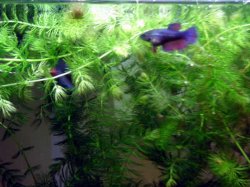Easystreet
New Member
- Joined
- Jun 8, 2005
- Messages
- 41
- Reaction score
- 0
Hello all,
I need something to help me with the war against algae. I have sand colored algae growing on my silk plants, gravel, and glass in my 6 gallon eclipse tank. I can win the fights, via regular cleaning, but the war seems to be in the algae's favor. I was thinking of getting my batta a roommate who enjoys the fine dining my tank has to offer. Do you have any suggestions? It has been suggested to me by a friend to acquire a Green Apple Snail or a Plecostomus. What say you?
- Jason
I need something to help me with the war against algae. I have sand colored algae growing on my silk plants, gravel, and glass in my 6 gallon eclipse tank. I can win the fights, via regular cleaning, but the war seems to be in the algae's favor. I was thinking of getting my batta a roommate who enjoys the fine dining my tank has to offer. Do you have any suggestions? It has been suggested to me by a friend to acquire a Green Apple Snail or a Plecostomus. What say you?
- Jason

